Long ago, when I wanted a plywood sheet, I would go to the local big box hardware store and buy whatever was at the center of the optimization curve for cheapest and nicest looking. I would inevitably suffer with ultra-thin veneers on the top, ugly cores, unfinishable edges, warping, voids, and other maladies of the common plywood. One day I said enough is enough and bothered the salesman at my local lumber supply until he showed me one that wasn’t awful.
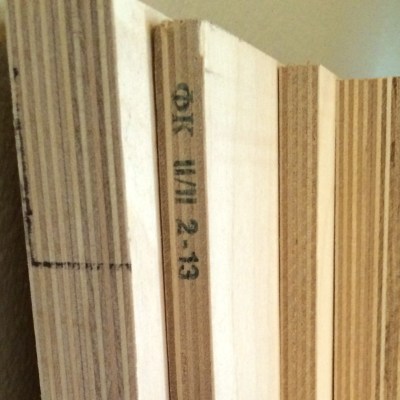
Baltic birch differs from other plywoods in a few ways. Regular plywood is usually made locally from the cheapest possible core wood in alternating grain layers laminated together with a hardwood veneer on the top. There are interior and exterior grades. The exterior grades are usually made with a different glue, but don’t necessarily denote a higher quality or stability. Some of the glues used can be toxic. Wear a respirator. In normal plywood, the ATSM or BB standards only apply to the face veneers used to finish the product. The core can be of whatever quality is convenient for the manufacturer.
True Baltic Birch is made in the Baltic Region with the biggest producers being Russia and Finland. Outside of the US it is sometimes called Finnish Birch or Russian Birch plywood for this reason. It is made from only top quality birch veneers laminated together with no filler wood. It is also unique in the care taken to make sure each layer of the wood is patched so there are no voids. All Baltic Birch is made with exterior grade glue, and when properly sealed will work for outdoor applications. There are grades of Baltic birch for marine applications and exceptionally void free aircraft grade plywood at a much higher cost.
The easiest way to spot Baltic Birch if you’re American is its form factor. Baltic birch comes in 1525 x 1525 mm squares, which approximates to 5 ft x 5 ft. Some people have said that manufacturers have started to produce 4 ft x 8 ft sheets specifically for the North American market, but this information comes with a caveat that these are usually lower grades made locally or in China parading under the name. The metric form factor extends to the thicknesses of the sheets. In America they will be sold as inch, but fit pretty closely to a metric form.
- 3 mm ≈ 1/8″ (3 plies)
- 6 mm ≈ 1/4″ (5 plies)
- 9 mm ≈ 3/8″ (7 plies)
- 12 mm ≈ 1/2″ (9 plies)
- 18 mm ≈ 3/4″ (13 plies)
– From [3] Ultimate guide to Baltic birch.
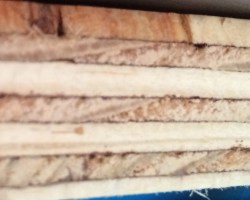
There are some really nice practical features of Baltic Birch. One of my favorites is the absolute uniformity of the layers. This means that two pieces of birch can be laminated together and the seam between the two becomes indistinguishable. I’ve used this to make cases by CNC routing out the inside of a sheet of Baltic birch, drilling some holes for alignment pins, and then laminating the whole assembly together. We’ve covered a few readers who have had similar ideas. Since the layers are uniform you can also do interesting things when combined with a CNC router. For example, carefully milling away the layers you can get a topographic map of the object.
Baltic Birch is also significantly flatter and more stable than other plywood options. It is commonly the material used for fences on expensive tables saws. It moves less during temperature swings and changes in ambient moisture. This is one of the reasons it’s popular with fine furniture builders. This also makes Baltic birch a good option for home CNC builds, certainly better than MDF . Due to the higher quality wood and better manufacturing it is quite strong as well. It is a great structural wood.
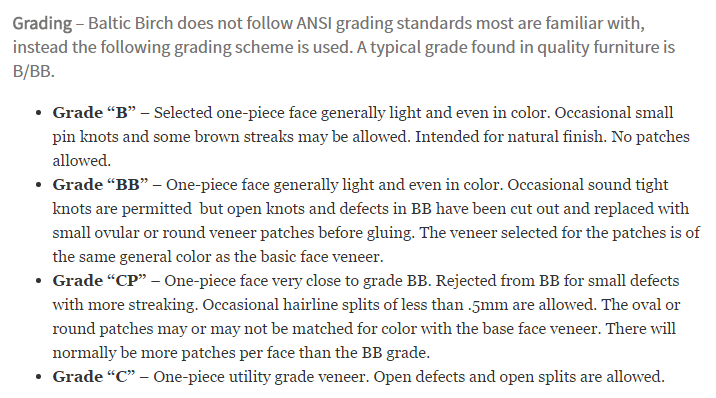
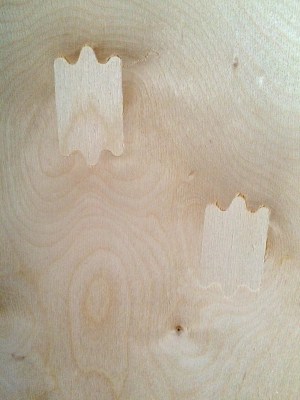
Baltic birch is more expensive than the regular grade stuff. So a sheet of ¾” thick Oak veneer plywood with a pine core, interior grade, from Lowes is about 35 US dollars where a similar sheet of 18mm Baltic Birch will run around 65 dollars.
I’ll still occasionally purchase a cheaper sheet of plywood when I have a non-critical application (like garage shelving), but when I am doing something precise or nice I’ll spend the extra on the birch plywood. While I love this material, I am by no means a wood worker. Have any of you had experience with this plywood? Is there an even better plywood out there?
I’ve left my sources below for further reading. [3] Ultimate Guide to Baltic Birch is very good.
[1] Dan’s Hobbies. (2016). A baltic birch plywood primer | Dan’s Hobbies. [online] Available at: http://www.dans-hobbies.com/2010/01/09/a-baltic-birch-plywood-primer/ [Accessed 19 Apr. 2016].
[2]Wikipedia. (2016). Plywood. [online] Available at: https://en.wikipedia.org/wiki/Plywood [Accessed 19 Apr. 2016].
[3] Stephens, (2014). Ultimate Guide to Baltic Birch Plywood: Why It’s Better, When to Use It |. [online] Woodworkerssource.com. Available at: http://www.woodworkerssource.com/blog/tips-tricks/your-ultimate-guide-to-baltic-birch-plywood-why-its-better-when-to-use-it/ [Accessed 19 Apr. 2016].

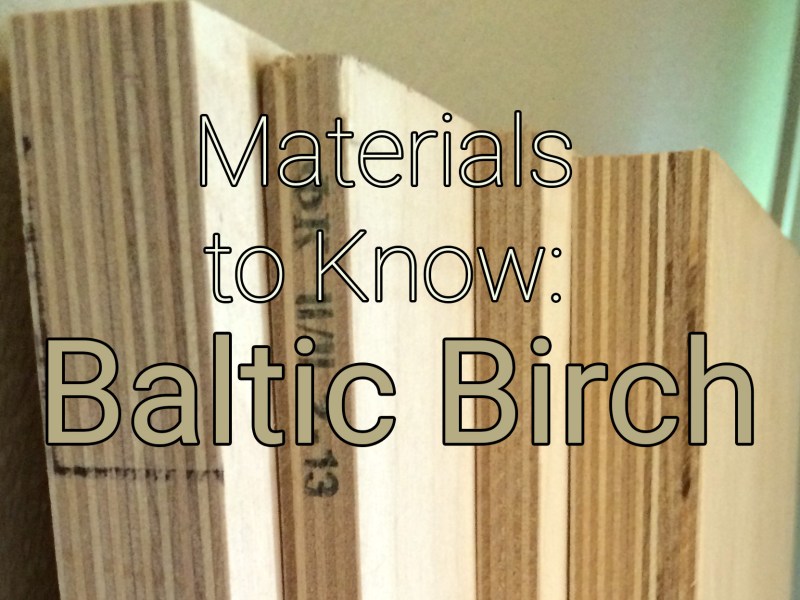














Baltic birch is the same as other plywoods in a few ways as well. Namely that it is still plywood. Which means it still contains formaldehyde, still molds, warps, absorbs moisture, is flammable, is heavy yet not terribly strong, is pretty terrible to breath in when working with it. It’s cheap, though, so there’s that.
What material do you use instead?
A graphite nanotube fibers weaved with platinum and the tears of my enemies mostly.
I’ve heard that’s a pretty good material, but graphite nanotube fibers are pretty much asbestos, so it’s not a good trade over the glue in some plywoods.
That’s what the tears of your enemies are for; when painted on under a full moon with the proper invocation it renders the item impotent to cause you any harm. (See Necronomicon, Chap 4 Stanza 27)
Awesome.
Depends on the application. There is no one “best” material for every application. I just have a hard time finding great uses for plywood, unless you are trying to minimize costs or need a large amount of material.
That’s exactly the best application for plywood, and why it’s used so much in construction (where you need large amounts of material and cutting costs is critical).
Acrylic plastic can be cut and drilled easily with common tools used for woodworking, is more strong than plywood and can be bond together easily with a solvent. It is not the strongest plastic but less expensive compared to other plastics such as policarbonate or derlin, easy to work and gives easily a good result. Very often the suppliers that sells small sheets of this material overprice it greatly so it counts a lot to find a cheap supplier. as a reference i pay about 7.2$ for a panel 1ft x 2 ft x 6mm.
>Which means it still contains formaldehyde
Here in Russia we do have a sort of plywood called FBA (ФБА).
It’s made with some special albumin-casein glue and is completely eco-friendly.
The only problem is that plywood is not that much moisture-resistant.
Wood bound with milk and egg protein… Hmm, sounds like what we in the USA call an Egg McMuffin.
That really does sound like the recipe…
It’s a recipe alright. A recipe for mold in the presence of moisture.
The glue is formulated with sodium hydroxide, so it’s not exactly directly edible. It’s kinda like fish preserved in lye.
Or a typical public school breakfast.
Especially plywood part
This sounds like a good adhesive for laser cutting. The outdoor adhesives tend to melt instead of ablate with lasers less than 120 W.
Find me a wood that doesn’t mold, warp, absorb moisture or burn.
In Rod We Trust
http://amzn.to/1qRbsPX
I think you are going to have to look beyond wood to find what you are looking for.
ok we get it, you don’t like wood, any wood at all. Now please stop being so negative, please?
The guy does have a very good point. Unless I’m trying to make furniture, I wouldn’t consider wood for anything either, except perhaps as decoration – although that wouldn’t be plywood…
Wood is easily recyclable, repairable, non-toxic, doesn’t have weird hormone-like chemicals to it, it’s pleasant to the touch, looks nice, sounds nice, easily molded and shaped, cheap, widely available…
And it’s actually more fireproof than you think, because wood chars in a fire and char is an insulator that prevents the deeper layers from evaporating into the flame. It burns on the surface and generally retains its shape, unlike plastics which melt into a pool of flammable oil.
And wood is dimensionally stable along the grain.
Petrified wood, if it please…
Hi, you should look at the wood called tigerwood (i think it is the english name).
I know it under the name “muriacataria”, and it’s very hard, bugs don’t eat it, it doesn’t absorb much moisture, it is fire resistant, and mushrooms won’t grow on it.
I have two 4m planks oustide, they’ve been there for more than 5 years, with no alteration.
I live in a tropical area, so it rains often, and the rest of the time, it’s a srong sun.
About the resistance of the material, through, it’s not what i think, but what i found.
Here is a french document on it : http://tropix.cirad.fr/FichiersComplementaires/FR/Amerique/MUIRACATIARA.pdf
Waterjet…..obviously you haven’t used much Baltic Birch plywood that was made in either Russia or Finland. You are probably using the stuff made in China.
I use it all the time and it is so far superior than any other plywood…..it is strong, doesn’t mold (as I use it in boats), no warping, minimal absorption of moisture….but I usually seal it, and as far as flammable….toss a 2″ piece into a bonfire and see what happens to it…..it is like the wood from hell…..it will scorch, but as far as being flammable…it takes a heck of a long time to burn…..like forever. I’ve tossed a small piece into a fire watched it scorch…..pulled it out an hour later, other than black is unharmed….put it back in….and did this several times over and over….and maybe 5 fires later, it is finally consumed. So either you are getting crappy plywood that they are telling you it is Baltic Birch….maybe you only got good two sides.
Is it the same as “multiplex”? (Don’t know if this is a german speeking region thing…)
Yes
http://www.hornbach.de/shop/Multiplexplatte-Buche-18x1250x2200-mm/8197833/artikel.html
But this is another kind of wood (Birch in german is “Birke”), I don’t know the english word for “Buche”, which AFAIK is a harder wood.
I’d hazard it is ‘beech’. I find that unlikely, I’ve only come across beech as planks composed of small staves of beech. It usually is much redder than birch, so it may be an error on the shops part.
“Buche” would be beech in english.
Birke = Birch Buche = Beech
Then does this stuff contain formaldehyd too? The Hornbach page gives a 404 and did not enlighten me much… If it does, how do you cut / sand it without dying from the dust? Is a simple dust mask sufficient?
I really like the material (the beech variant) and have heavily used it for turning two vans into simple campers now. Though it is a bit heavy it is a very strong and forgiving material and I’ve never seen it mold btw…
Thanks (Danke)!
The 3mm B/BB Baltic birch is nice to make small boxes. Like the one I made for my PV16SOG project.
http://picatout-jd.blogspot.ca/2016/04/projet-pv16sog.html
I cut a lot of plywood, and whatever they put in it is 10x better (less stink/dust) than particle board or MDF. I have not used this baltic birch yet but it does look very nice.
True, I way prefer working with plywood than any particle board
I’ve gone through ~3 boxes of 1/8 inch baltic birch advertised as b/bb with my laser cutter and so far have only found one or 2 pieces that actually had plugs. I have had a few odd pieces where I hit knots in the inner layer that caused my run to fail. I have noticed pretty much every piece is slightly warped.
yes, warping occurs with all/most plywoods that are suitable for the lasercutter. Make sure you store the stuff absolutely flat. That glowforge lasercutter a while ago had a feature to adjust the focus for local warping.
Lowes and Home Depot have birch plywood. Is this Baltic Birch, or is it equivalent to BB? If not, is BB only available at independent lumber yards?
The birch plywood at those stores is very very rarely baltic birch, mostly just cheap plywood.
homedepot in canada has russian birch plywood but only in handyboard sizes (2’x4′)
It’ll just be standard plywood with birch veneer
Oh no… much worse than that. It has a poplar core with a very thin birch veneer. Careful with the sanding and has the structural worth of styrofoam. At least regular plywood has a pine core.
No, it’s the Chinese junk.
If you’re in the Maryland/DC area, both Harbor Sales and Chesapeake Plywood are good suppliers of B/B grade Baltic Birch in 4×8 and 4×10 sheets (sometimes even 5×10). They also have A/A and A/B grade “marine” ply and various hardwood plywood selections. Chesapeake Plywood can even sequence match your plywood if you want to make something really big with matching grain.
Boat building shops are a good choice for exotic plywood too. Chesapeake Light Craft has Okoume and Sapele. (And they have a wicked cool CNC router table that will fit a full 5×10 sheet too!)
Can’t vouch for Lowes but the Orange Box stuff is exactly that.
If I remember correctly, it’s sometimes not even Chinese per se but rather the boards that are rejects from the half-way decent stores. Sometimes from U.S. sources (rare) or from Canada or whatever. Or to put it another way, they’re the pallets that didn’t past muster bought in bulk amounts that only the box stores can command. Finding voids in their ply should an expected thing, not an exception, regardless of where the wood supposedly comes from.
Take a look at their redwood “hearts” to get an idea of how crappy their offerings are. Their idea of heart wood is when the board has “some” heart wood. You’re lucky to find boards with 50% heart wood much less anything approaching 90%. It’s been a few years but I think anything over 30% is considered “heart wood” as far as they’re concerned. They also have fake red dyed wood products. A cheaper line that supposed to “age” like real red wood. Their pressure treated wood is also embarrassing. You’ll be buying copper naphthenate to supplement that garbage.
You absolutely have to remember that the Big Blue and Orange Box stores target their product to the end home owner or moronic (or sleazy) sub-contractors. Not even HD’s own sub-contractors buy their supporting material from the store unless the customer buys it themselves. So the vast majority of those people wouldn’t know the difference between Douglas Fir and Cat Fur.
The only good positive thing I can think of to say about these big box stores is their ability to dump massive quantities of lumber into disaster areas that need them on short notice. There was a shortage of 4×8 boards of any type one year since every store from the West to the East coast was diverting their lumber shipments to Katrina areas. Could the smaller, higher quality, lumber stores do the same on such short notice? No idea….
There is always money to be made from someone else’s misery.
Called Chesapeake and no B/B grade available or brought in. Said can’t provide in B/B.
Never knew it actually came from the Baltic Region. Is there a reason we can’t make plywood with the birch we have here in the US? It seems like a really inefficient thing to ship across the ocean.
There’s some higher grades of domestic plywood out there – just not commonly seen in big box stores. A lumberyard, marine, or aircraft supply place might have them.
Most large microchips (think PC CPUs and GPUs) are assembled (the chip is put on a package) elsewhere then it was made, sometimes quite far, like US -> Malaysia…
Then there’s the supply/demand, large scale production in US would be expensive, so unless there’s enough demand for quality plywood, it’s cheaper to ship it from elsewhere.
Since I live in the “baltic” area (Sweden) I never knew plywood could be of lower quality then this, the reason why baltic birch is preferred is probably for it’s slow growth (cold climate), and the fact that we don’t have any insects/termites that ruins the wood.
One might expect Canadian birch to be similar, but I’m not sure.
We also have the birch that grows only in the mountains called “fjällbjörk” that grows even slower, and never gets tall enough for lumber, but it makes for beutiful smaller things, like knife handles and wooden spoons/forks/butterknifes.
The original sami people makes a lot of woodwork from this birch since it has beutiful grain and is really hard due to slow growth.
I prefer lauan myself. I’ve made a few pieces that look just fine stained with it.
meaning the 5/8 variety, not the veneer they sell at the big box hardware stores.
I guess it depends on where you get your wood from. I used to work for a cabinet manufacturer, where most of the materials used were domestically(US) manufactured Oak/Maple veneer with A grade faces, very nice looking. B faces were used for non visible parts. The wood we used was extremely good quality with excellent cores (everything is cut via CNC routers so voids and fillers can cause problems), but it was supplied via a distributor not from the hardware store. Also on jobs that request it (increasingly popular) we used NAUF (no added urea formeldahyde) certified plywood’s. You can look for that if health is your concern.
The article mentions the “unfinishable edges” of standard plywood. For straight edges, these are easily covered with iron on edge banding veneer and easily trimmed with a simple handheld device.
Flatter? That’s funny. My previous employer used 3-mil Baltic by the caseload. Some of the sheets would come off the pallet curled up like potato chips. It really is amazing stuff, though: strong, flexible, lighter than MDF, laser-cuts and CNCs nicely.
The curling problem is my biggest complaint about the product. Typically diagonally opposite corners curl towards each other, so you always have to account for that in your build – even up to 18mm. I once did get my hands on 25mm and 30mm scraps from a furniture shop in Latvia – these were perfect with no warp, excellent for making some benches. Now that I am back in the states I have been frustrated with the really poor quality plywood. Made a replacement piece for my old b&d workmate, only for it to break as soon as I applied a load (sat on it…) Now looking for some birch ply. Nearly impossible to break an 18mm piece of that by sitting on it… ☺
Veneer core plywood is prone to warping. I used to work at a cabinet shop, the veneer core is strong and great for structural parts, but the full cabinet structure prevented any warping. Door and drawer fronts, which had little structural support, were made from particle board cores which were much better at holding their shape. Out products where edge banded so you didn’t see the core. We had one style which used an integrated (routed) pull on the fronts, and for that we had to special order particle board core wood with hardwood framing (pieces were ordered to size, with a strip of hardwood in the core along the edges behind the surface veneer.
In the UK I can get 8’x4′ sheets of Birch ply – it’s fantastic stuff, especially its strength taking a screw into the edge of 15mm or 18mm. On many projects the reduced build time and reduced need for framing due to increased strength has offset the additional cost. For odd reasons I’m currently using it to make the blades for a set of canoe paddles – so lovely to work with!
There some domestic companies duplicating Baltic Birch. One I came across is called Appleply. Its not made out of apple wood but rather the apple term is used to designate its made in the US. Unfortunately its not offered in any of the big box stores that I know of, but they do have a list of distributors on their website. http://www.appleply.com
Oh, when I saw the title of the article I thought you were talking about this girl from Latvia I once knew.
I wrote about it here. http://www.diybookscanner.org/archivist/?page_id=326
One point made, but possibly not given enough prominence is that it is REALLY worth talking to your local timber merchant, even if you’re only buying a single sheet; mine was perfectly happy to deliver.
The big DIY places are hugely expensive (in my case about double the price) and the quality is generally bad as you’re getting what a hundred other people have picked over and rejected.
I then contacted the two big national builders merchants in my area, one quoted me a price barely better than the DIY place and the other didn’t respond and a phone call later revealed that the guy who quotes prices is on holiday (which begs the question of what the rest of the staff were doing that week).
Finally I contacted a smaller regional chain and got an email back from the branch manager with a great price 5 minutes later.
” Some of the glues used can be toxic.”
Treat all glues used for making plywood as toxic because they often have a nasty pesticide mixed in to it.
Phenol-formaldehyde glue used in a spruce plywood often contains xyligen 25(really nasty fungicide).
Also of note: Baltic Birch is the preferred material for building bass bins. That same lack of voids and high degree of consistency is part of what makes MDF so attractive for making speakers, but the birch ply is far stronger, so you can make lighter subwoofers with thinner panels and less internal volume lost to bracing.
Preferred material to make speaker boxes out of also
@Gerrit Coetzee I think it is worth a new article dedicated to fastening plywood (or MDF, carbon fiber, and fiberglass). Plywood becomes an even better choice when you understand how to construct boxes, or attach it to other objects. Understanding fastening methods, including inserts, corner bracing, and other common construction technique will make wood an easy choice compared to the “known” materials I see featured here (laser cut plastic, 3d printed) and the tools to construct are easily found at the local store.
I’m a bit surprised by the negativity some people have for wood. I think a lot of people misunderstand it. Wood is a unidirectional composite, and behaves like any unidirectional composite (eg fiberglass or carbon fiber). It is very strong in the direction of the grain but weak across the grain. Plywood layers are built up to overcome the weakness by alternating the fiber direction. Aside from composites such as carbon fiber and some ceramics, wood can have a higher strength to weight ratio than metals, and far exceeds all plastics. Balsa is commonly used in composite sandwich cores with carbon fiber skins (Corvette floor boards a few years ago used this) or metal skins (aircraft floor boards). Just like any material, if you know it’s strengths and weaknesses, you can understand how to best use it.
I think that’s a great topic! I’m not the best wood worker. Do you know of books on the subject I could read as research to make sure to cover the subject fully? I agree that once you start to think of it as a composite it begins to work in your favor. I intentionally bought some that was badly bowed the other day for use as shelves:) It’s already preloaded in one direction. When I put books on it I got perfectly flat shelves instead of ones bowed towards gravity, haha.
Here here.
I’m currently making a 3 foot monitor arm out of some really high quality plywood that I’ve doubled up.
If you’re familiar with grained materials, it’s the easiest and some of the safest material to work with, plus it doesn’t corrode or break down in UV.
I made boomerangs out of “airplane” plywood, 5mm thick with 10 plies and that the good stuff, Baltic or not.
I’m not particularly worried about what the material I use to build my spaceship will do to the earth. As long as its able to resist solar radiation and protect me from the void. That is of course, once we have rendered the earth uninhabitable with our waste and pollution.
I do like Baltic birch. A pleasure to work with. It requires very little aesthetic repair work. Its fairly stable. It can still warp, like all plywoods, but much less than a pine filled birch veneered plywood. The highest grade baltic birch isn’t available to me , I get BB/BB which has random footballs, that fill holes or knots, on both sides. I usually have to decide which side looks better for my exposed surfaces. There is always a better side.
I’ve spent a lot of time being a real carpenter with traditional equipment and solid wood. I know the pride you feel when you run wood through the jointer, the planer, then the table saw to achieve your final dimension. That precise, perfect, crisp edge, that only finely tuned tools can achieve. I used this same attitude and approach to make my cnc machine. So if I made the machine, can we say that everything that is made with the assistance of the machine is made by me.
I like the way baltic birch looks. I grew up riding skateboards, so the thin, numerous plies are aesthetically pleasing to me.